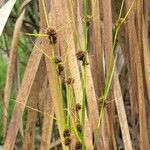Plants perennial, cespitose, 100–150 cm; rhizomes absent. Culms erect to excurved ascending, narrowly linear to ± filiform, terete to obscurely trigonous, leafy, densely so toward base, stiff to rather lax. Leaves overtopped by culm; blades linear, ascending, proximally flat, 1–4 mm wide, apex trigonous, subulate, tapering gradually. Inflorescences: spikelet clusters 1–3(–4), proximal mostly widely spaced, dense, broadly turbinate to hemispheric, to 2 cm broad; leafy bracts subulate, exceeding proximal spikelets, slightly or not exceeding most distal clusters. Spikelets red brown, narrowly ovoid, (3–)3.5–5 mm, apex acute; fertile scales ovate, 3–3.5(–4) mm, apex acute, mostly with cusp or mucro 0.5–1 mm. Flowers: bristles 5–6, from rudimentary to reaching tubercle tip, or (rarely) beyond, antrorsely barbellate. Fruits 1–3 per spikelet, (1.5–)2–2.2(–2.5) mm; body dark brown with pale center, lenticular, broadly ellipsoid to ± orbicular, (1.3–)1.5–1.7(–1.9) × 1–1.5 mm, margins pale, narrow or narrowly rounded, flowing to tubercle; surfaces dull, minutely longitudinally striate; tubercle compressed, triangular to triangular subulate, 0.5–0.7(–0.9) mm.
More
Cespitose, erect to 1 m, relatively coarse, the stems 1.5–3 mm thick near the base; lvs filiform or to 4 mm wide, no more than half as long as the stems; terminal glomerules broadly turbinate to corymbiform, 5–25 mm thick, or compound and to 5 cm wide; lateral glomerules 0.3, usually remote, conspicuously pedunculate; spikelets 2.5–4 mm, with 2–4 fls and 1–3 frs; bristles (0–)6, antrorsely barbellate, variable, up to as long as the achene; achenes elliptic to subrotund, brown, sometimes pale at the center, 1.3–1.7 mm, three-fourths to fully as wide; tubercle deltoid, 0.3–0.8 mm, up to half as long or sometimes fully as long as the achene. Wet acid soil on the coastal plain; trop. Amer., n. to Tex. and se. Va.


